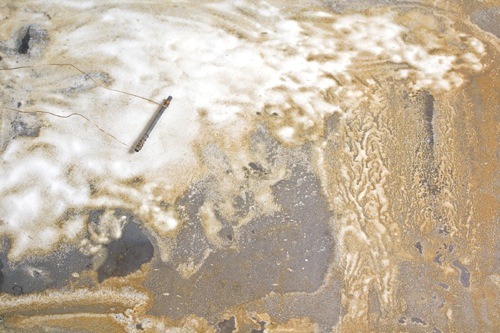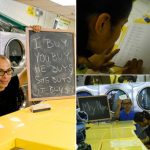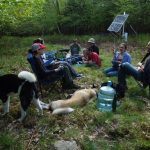Meet a NYFA Artist: Joe Brittain
NYFA speaks with 2011 Sculpture Fellow Joe Brittain.
NYFA: Hi Joe, please tell us what you’ve been working on and what’s coming up for you.
JB: Currently I’m finishing a group of new sculptures for a show at Regina Rex gallery in Brooklyn, opening January 14th, curated by Lauren Portada. In these new works the very large (the largest element being the earth’s magnetic field) effects the very small and the very small effect the very large (the smallest elements are electrons being stripped from steel to make rust). I’m excited by the subtly active nature of this new work. Unlike past works, they’re more related to metonyms than metaphors, they present rather than represent. For me they are functional diagrams or maps made to help orient one’s place in the world.
NYFA: How did you begin working the way you do now? Has your practice evolved over time?
JB: I arrived where I am now through a lot of experimentation. Having studied Art History and worked for a series of older, more established artists, I tried my hand at a lot of different practices and a lot of different techniques. Then about a year ago, I moved into a new studio and started from scratch, slowly introducing new, very basic materials into the space while constantly making drawings. In this way, I was able to edit down to a practice that felt like my own. Around the same time I also came to the realization that being an artist doesn’t necessitate being an inventor. I greatly admire those artists who build new unique worlds for us to look into but it was a great relief and turning point for me when I realized that I didn’t have to do that. I’m much more comfortable in the role of discover/presenter than inventor.
NYFA: Can you talk about the materials you use? What draws you to the mix of mediums you employ?
JB: A love of the material world and history forms the base of my practice. When I say material, I mean the raw matter that builds us and our environment. I like to think of my materials as the result of a constantly churning mixture of matter and energy over eons. Lately, I’m drawn to materials that although not often thought about as energetic, can be seen as actants when looked at in a different way. Fossils, chemicals reactions, magnetic fields, home made batteries, crystallizing salt are all working their way into my new sculptures as ways of presenting a process and visualizing energy and thought.
NYFA: How does a project or piece begin for you?
JB: Most often it begins with me being drawn to an object, a kind of rock or a piece of antique lightning rod for example, spending time unpacking why I’m so drawn to it and then essentially I create a diagram of this attraction.
NYFA: Who or what is influencing you most strongly right now?
JB: At the moment I’m interested in cork, Mario Merz’s Fibonacci series, the poetic implications of quantum physics (mainly that matter is energy and energy is matter), The projects of a research group called “The Friends of the Pleistocene”, a stretch of high desert mountains in South West Texas, black glass, the incredible book “Vibrant Matter” by Jane Bennett, the videos of Tommy Hartung, magnetic fluids, pine tar resin, and my constant studio companion, the free form radio station, 91.1 WFMU from Jersey City, New Jersey.
NYFA: What is your studio or work area like?
JB: I have a little slice of a repurposed factory building in Brooklyn, floor and counter space are occupied with ongoing material tests and hand tools, while the wallspace is filled with process drawings. There is always coffee on.
NYFA: Do you make a living from your artistic practice?
JB: Not yet, though I just started showing my art this year. I’m very grateful to now be represented by an excellent gallery called Toomer Labzda Gallery and I look forward to working with them for a long time.
NYFA: Do you have expectations for reactions to your work?
JB: I, of course, want people be interested and invested in my work and for it to have a long life after I put it into the world. To make this happen I feel it’s important as the maker to be genuinely excited about what I’m doing. Without the maker’s excitement, the audience will never become excited. The most enjoyable part of the process to me is the making, so it’s my main hope that reactions to my work will be such that I’ll be able to continue making.
NYFA: How has the NYFA fellowship affected you?
JB: It has been a huge vote of confidence at a crucial early point in my career. The funding has allowed me to finally work with materials and tools that I’ve been shying away from for years. I’ve also been able to employ some extremely talented fabricators and machinists. Within the fellowship itself, it’s been great meeting this year’s group of passionate, interested artists and I look forward to the Artists and Audience Exchange aspect of the Fellowship. I’ve always wanted to teach but have not yet had a chance to do so.
To learn more about Joe Brittain, visit his website and blog.





